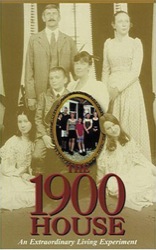Today, we’re going to take a step outside of our usual bailiwick and talk about living history. We have been involved in various aspects of living history for over 30 years and while our involvement in recent years has been scaled back, we still have fond and not-so-fond memories of the various situations we found ourselves in. In many ways, living history the logical end-result for why historical garments are created and it presents the participant with an unparalleled opportunity to go back in time, at least for a moment, and get a taste of life in a past era. While there has been much debate over the years as to whether or not this form of “time travel” can truly give someone an authentic experience, it can not be denied that it does put present the participant with situations that are decidedly not typical of 21st Century life (at least in the Western World).

Taking aim at history…
And now we take a look at what happens when you take modern people and inject them into the past…
In recent years, reality TV has become, for better or worse, a major element in the cultural landscape. Shows like Big Brother, Survivor, and a host of others typically, these shows feature a group of people drawn from various backgrounds who are then put together in a close living situation such as a large apartment in a strange city, deserted island, or some otherwise remote wilderness location. The whole idea is to see how people react to being taken out of their normal environment and then forced to interact with others. The primary goal is to stimulate and maintain viewer interest by generating some sort of conflict or at least placing the show participants in situations that are sure to generate conflict and drama as a means of maintaining viewer interest.
For us, one interesting variant has been the living history reality show which involves taking a group of modern day people with varying backgrounds and then placing them into a recreation of life of a past era. Some of the more noteworthy (or notorious, depending on your point of view) have been 1900 House, Frontier House, Texas Ranch House, Edwardian Country House, and the list goes on.


However, while seeing living history come to life on the big screen (well, little screen since it was TV) is interesting and definitely a worthy goal, the reality show format tended to get in the way, especially in the way some situations were seemingly manufactured to either generate conflict (classic personality clashes) or made to make a show participant look bad (typically someone complaining about the lack of X modern convenience). It definitely grew tiresome to the point where we simply stopped watching as in the case of Texas Frontier House (we subsequently tried to watch some of the missed episodes in an effort to be fair but it was still unwatchable).

What was especially obnoxious was people complaining about how hard life was “back then” and especially for those who were in the servant/laborer categories. Well guess what? It was hard and they should have been under no illusions it was going to be otherwise. In fact, the conditions recreated for these various shows was no doubt a lot less rigorous than what it actually was during the various historical periods being portrayed. We can only assume that the show producers were going for the usual fish-out-of-water culture shock but some of the show participant reactions were excessive.
Unlike the people of the period, the one thing that the participants had going for them was that it would only last a limited amount of time and they would be able to return to their normal lives. For the people of the period, it was home and that was that. One would have thought that people would be willing to suck it up on a temporary basis and just deal with whatever situations were presented to them.
It’s easy for us to take potshots at these shows and trust me, we’ve gotten many a laugh pointing out people’s faults and commenting on the poor costuming. However, at the same time, we need to realize that it still represents major effort on the part of the show participants and that is to be commended, even when things didn’t work out correctly. If nothing else, it also acts as a bit of a reality-corrective lest we have too rosy a view of past life (in our case, the 19th century).
While there is much that we find fascinating and attractive about the 19th Century, we also know its downside (and in some cases, darkside) and we harbor no desire to “escape” to the past (although a short visit would be fascinating if the means actually existed 🙂 ). At the same time, when considering any sort of living history experience, we have to be mindful that we are not letting our 21st Century attitudes color what we see and believe. So as with everything one sees and hears, it should be taken with a large grain of salt.
In conclusion, while there’s much to be learned by watching and participating in living history, we believe the reality show approach is not the most effective although it can be entertaining and with that, we’ll leave you with the thought that “there’s no place like home.” 🙂

Our version of the “1905 House.”
Like this:
Like Loading...








































